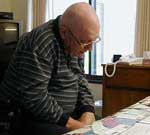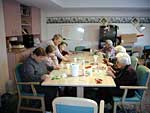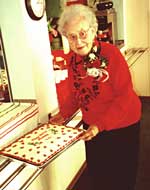
|
Sorting the Options
By Tom Scheck, Minnesota Public Radio
March 2001
|
|
RealAudio |
A state task force has recommended that Minnesota shift its reliance on nursing homes toward less-costly assisted-living alternatives. Forty-thousand Minnesotans now live in nursing homes, even though state officials say many could be living on their own with some assistance. This legislative session, Gov. Ventura and the Legislature are working on ways to prepare the long-term care system for the state's retiring baby-boomers.
| |
|
|
|
||
"My wife took care of me for quite awhile and it just got to be too much; we had a roundtable discussion and they all agreed that the best place would be in the health care center like this," he says.
The federal government's Medicaid program pays most of the tab for nursing home care.
In Minnesota, 35,000 of the 40,000 nursing home residents are on Medicaid. Yet while thousands of nursing home residents like Neubauer require 24-hour care, others only need a little help, perhaps a hand getting dressed or assistance with a meal.
Robert Kane, the chairman of the University of Minnesota's Center on Aging, says a growing number of seniors don't need full-scale nursing care. He says 80 percent of the state's elderly live in their own homes and would like to remain there. He says many see nursing homes as over-regulated and dreary.
"Why is it all of a sudden people decide when you get up in the morning, when you go to bed, what meals you eat and what activities you go to? It's clearly more economical to do that, but it's not what we as Americans prize," Kane says.
Kane says Americans prize their privacy and want alternatives that place fewer restrictions on their independence. In response, an industry has emerged to provide limited care in the home or in an apartment complex setting.
"When your parents got old and feeble, you sent them to the nursing home. Somebody woke up one day and said 'why?' What is the nursing home? Well it turned out that didn't provide a lot of nursing and wasn't very home-like. We began to look at that and say, 'Is this really a place where people should be living for five to 10 years?' People want more than that," Kane says.
Assisted-living providers will develop specific care plans for individuals for a fee that varies with the amount of care provided. The price ranges from $700 to $4,000 a month. Assisted-living facilities often specialize in certain types of care, such as Alzheimer's disease.
| |
|
|
|
||
Judy Eddy began going through the options when her 96-year-old mother, Val Ranney, fell and broke her hip last October. Eddy and her two sisters were presented with a dilemma: Do they move their mother into a nursing home, her old apartment or into an assisted-living facility? Even though Ranney needs a walker and help putting clothes on, Eddy says her mother is self-sufficient.
She says they wanted a place that would provide assistance but not interfere too much with her daily life. "It's a really hard time of decision-making and knowing what's best for her and trying to help her maintain her dignity in a time when you know it's kind of hard to come by at times," she says.
In the end, Eddy says her sisters and mom decided not to put the 96-year-old into a nursing home because she didn't need around-the-clock care. They moved her into a Brainerd assisted-living facility.
Eddy's situation worked out partly because her mother saved for such a situation. A federal study has found that eight out of 10 people who live in assisted-living pay for it out of pocket. The government provides support for lower income Minnesotans but far less than it spends on nursing homes.
The Department of Human Services says the state and federal government has spent $847 million on nursing homes versus the $89 million spent on assisted living and home care services in 2000.
LaRhae Knatterud is the planning director for the Minnesota Department of Human Services's Aging Initiative. As the state's baby boomers start needing long-term care, she says Minnesota needs to invest more Medicaid money into community-based programs. If the state doesn't, she says, availability of care will divide between the haves and have nots.
"This issue about having the poor in a nursing home and the rich in assisted living is a concern not just in Minnesota, but in other states as well. What we're trying to do in that area is encourage affordable assisted living," according to Knatterud.
Knatterud says the state is encouraging affordable assisted-living by providing grants to renovate existing government housing for seniors. By marrying home-based care to senior housing, she says the state is establishing assisted-living settings.
At the Central Towers complex in downtown St. Paul, seven elderly women are busy making Saint Patrick's Day decorations. Knatterud says the senior-housing complex transformed itself into an assisted-living facility in 1997. The 197 apartment complex provides meals, nursing care and social activities for lower-income seniors.
| |
|
|
|
||
"The freedom and the care are the two beautiful features of an assisted-living home, because we're never alone and yet we can be alone in our apartment," she says.
The state's long-term care task force says the initial investment to create assisted living options will cost $113 million over the next two years. The nursing-home industry wants $500 million to renovate buildings to become more "home-like" and to develop assisted-living facilities within existing buildings. They also want to loosen some state regulations.
Critics of a shift from nursing-home care say the savings assisted-living facilities can provide may come at the expense of care. They say the loose oversight that provides a senior independence may compromise safety.
In Minnesota, the state requires the licensure of home health-care agencies but little additional oversight. The health department will do facility inspections once every 10 years or when a complaint is filed.
Attorney General Mike Hatch wants to require assisted-living facilities to specify the services they offer. Those that fail to deliver could be sued for fraud or breach of contract.
"As time has gone on, the assisted-living center has become a look-alike to the nursing home and right now we have a double-breasted system," Hatch says. "The irony is the assisted-living center is much better looking and maybe even some places the food is pretty good. But what we're also finding is the care is terrible in many of these cases."
Hatch came up with his proposal after settling a suit with an assisted-living facility that had numerous complaints for not providing advertised services. He says such problems could become the norm without better oversight.
Assisted living advocates and aging experts caution that providing too much oversight could hinder the freedom that is the main attraction of assisted-living facilities.
| Part Two: Toward a Better System |



